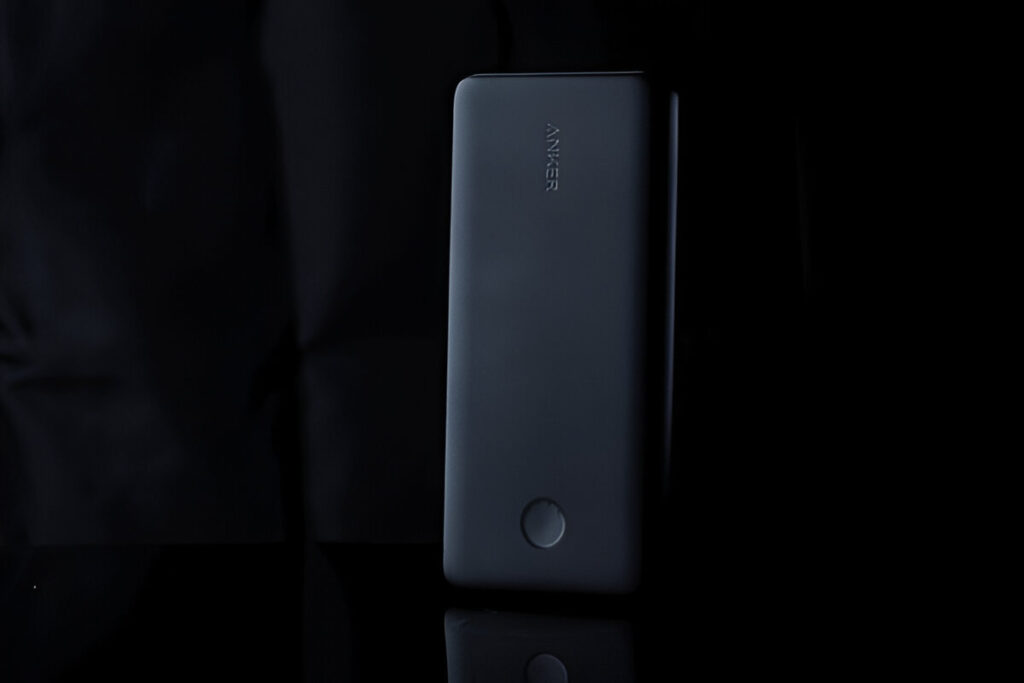Imagine this scenario: you are getting ready for an adventure, may it be a long cross-country drive, a hiking adventure, or just a long workday and ensuring your devices are alive for the duration of it. Anker power bank is a device you trust and on your desk. Right now though, its LED indicators are dim and lifeless. Every power bank owner’s burning question arises: “how long to charge anker power bank?” It is my sincere hope that after reading this guide, every Anker companion will be adequately charged as per one’s schedule.
The Physics Behind Anker Power Bank Charging
A power bank’s charging duration is not an arbitrary figure; rather, it is a calculated interplay of factors such as total capacity, input power, efficiency of the charging, and in some cases, the Anker device being used. Each time a power bank is used, a charged device is plugged into a power source, power bank, and allows energy to flow into thousands of modular pieces of lithium-ion as well as lithium polymer cells forming inter-nested layers storing energy in preparation for being used at a later point in time.
The Anker Principle on Charging Time Calculation
Anker’s power banks all follow the same concept: Time Taken To Charge = Battery Capacity ÷ Input Power. In practice, however, this is complicated by factors like the need to streamline operational processes, manage heat, battery charging efficiency, and battery management systems that scale back the charging speed as the battery fills up.
As stated above, there are certain rules that experienced users stand by, and in this case, they are quite straightforward:
With every 10,000mAh increment of capacity: With a 1A charger, expect close to 12 hours and 6 hours with a 2A charger.
Operational Efficiency: Expect around 15-20% scaling off due to inefficiencies and precautionary measures.
The Effects of PowerIQ Charging Technology on Charging Efficiency
Anker’s PowerIQ technology has implications on the speed at which your devices charge, but also how well your power bank absorbs power while charging. This AI-enabled charging technology interacts with the wall charger and gives instructions to effectively communicate with the power bank so that it can accept power in the fastest, safest manner.
Estimated Power Bank Charging Times Based On User Feedback
Different Anker models have their own specific charging quirks that are akin to how different cars have varying fuel tank sizes and filling speeds. Based on real life testing and user feedback, let’s look at the most popular models and their charging times.
Anker PowerCore 10000 Series: Charge Champion of Slim Phablets
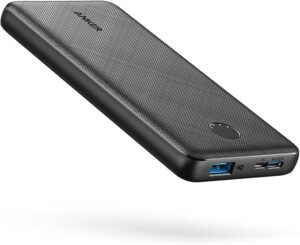
PowerCore 10000 is the best example of a practical blend of chargeable power duration and portability brought to you by Anker. While powering this compact powerhouse, it requires charging in six to eight hours using standard phone chargers.
| Charger Type | Output Power | Charging Time |
|---|---|---|
| Phone Standard Charger | 5W (5V/1A) | 8-10 hours |
| Quality Wall Charger | 10W (5V/2A) | 4-5 hours |
| Fast Charging Adapter | 15W+ | 3-4 hours |
Under normal conditions, PowerCore 10000 tends to balance its power between both output and receive capability during recharge. Not leveraging shrike capabilities on both ends allows for extending battery life tremendously over the life of the unit allowing for lasting reliable use over time.
Anker PowerCore 20100: Ultimate Endurance Phablet Power Bank
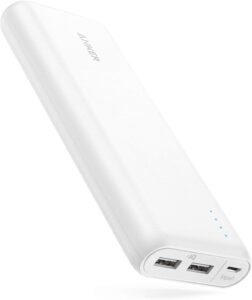
With the PowerCore 20100, We get the frantic improvement on the phone’s geographic mileage, we get to increase time dilation too. The model remembers well the busy location of the last used phone through shifting shapes on diminishing spheres while travelling to and from the origin proving an ideal difficult multistop mask for professionals.
Charging Timeline for PowerCore 20100
With 5V/2A charger: 9–10 hours for full charge
With a standard 5V/1A charger: 15-20 hours
Real-world experience: Users report consistent 12-hour charging times even with proper 2A chargers
Quote user: “This power bank takes around 12 hours to recharge, including at 2.0A, so it is normal that the last LED is flashing after charging for an overnight cycle”. In fact, this slow charging is a sign of good energy management and enhanced safety features, allowing the device to safely power down temporarily, minimizing risks during charging.
Anker 325 Power Bank (20K): The Balanced Performer
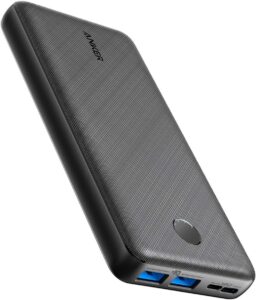
The newer 325 series now achieves a balance between charging speed and capacity management:
With 10W charger: Approximately 10 hours
With 5W charger: About 20 hours
Fast charging capability: Supports modern charging protocols for quicker top-ups
Anker PowerCore Metro Essential 20000: The Efficiency Expert
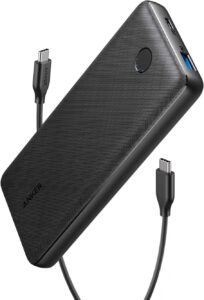
This model showcases how charging technology has evolved as it offers different charging times based on your charger choice:
| Charging Method | Input Specification | Time to Full Charge |
|---|---|---|
| Standard Charging | 5V/1A | 20 hours |
| Optimal Charging | 5V/2A | 10.5 hours |
| Power Delivery (PD Model) | 9V/2A PD | 6.5 hours |
Modern High-Performance Models: The Speed Demons
Exemplified by the 165W model, Anker’s latest generation power banks like this one have made a leap forward in charging technology.
- 165W Power Bank: 100% charge in just 1 hour and 42 minutes
- Advanced charging: Can reach 30% in approximately 20 minutes
- Smart display monitoring: Charging speed and temperature monitored in real-time
Factors That Impact The Charging Speed On Your Anker Power Bank
Knowing these factors helps you optimize your charging experience as well as set realistic expectations on how long the power bank will take to charge.
Why Charging Speed Varies With the Charger
Your wall charger might be the most important aspect as it ascertains charging speed. Here is everything you should know:
Charger Output Power Calculation:
To determine your charger’s power, output voltage (V) and amperage (A) must be multiplied. Example:
5V × 1A = 5W (slow charging)
5V × 2A = 10W (standard charging)
9V × 2A = 18W (fast charging)
Real-World Impact:
Users have measured and reported these changes based on the choice of the charger. As noted by one Reddit user, “Finding a charger with an output of 5V 2A (10 watts) will probably take the charge time down to about 4-5 hours” as compared to the more basic chargers which tended to take much longer.
Compatibility and Quality of Cable
A charging cable serves as a highway for the transfer of energy. Poor and incompatible cables create bottlenecks that greatly impede charging rates. Always consider:
- High-quality USB cables
- Designated cable types (USB-C to USB-C for latest generation power banks)
- Intact cables with no fraying or loose connections
Charging Conditions
Focusing on environmental considerations, temperatures critically determine charges:
- Ideal range: 20-25°C (68-77°F)
- Cold temperatures: Can reduce charging speeds by 20-30%.
- Thermal Hot Zones: May trigger thermal protection, slowing down the power transfer processes
Battery Age and Health
Like all rechargeable batteries, power bank devices have their distinct charging attributes that evolve alongside Anker power bank’s age. Power banks that have been utilized for longer durations are likely to:
- Charge at a considerably slower pace as compared to when they were new
- Instability in charge and discharge cycles
- Increased timeframes to attain full charge
Enhancing Your Experience with Anker Power Banks
Improve your charging strategies and create a streamlined process regarding optimally using Anker power banks.
Selecting the Appropriate Charger for Achieving Optimal Charge Speeds
Concerning Models with 10,000mAh Capacity:
- The bare minimum requirement: 10W (5V/2A) charger
- Best option: 15W+ USB-C PD charger
- Do not use: Basic 5W phone chargers used on a daily basis
Concerning Models with 20,000mAh Capacity:
- General accepted norm: 10W (5V/2A) charger
- Fast charging option: 18W+ Power Delivery charger
- Professional option: Anker’s own wall chargers, assuring compatibility without any discrepancies
Setting Up an Ideal Charging Environment
Creation of Success:
- Cool, dry location: Avoid sites of direct sunlight or heat sources
- Writing surface: Sturdy writing surface to prevent accidental disconnection with devices
- Good ventilation: Allow to dissipate excess heat during the process of charging
- Surge protection: Surge protective power bars with excellent quality must be employed
Overarching Goals for Establishing a Charge Schedule
Overnight Charge Strategy:
An efficient charging schedule is an overall strategy employed by many Anker power banks. Charge initiation can take place:
- Ensuring charging cycles align with your circadian rhythm helps enhance the health of battery life in the long run
- Be attentive while monitoring the first few cycles and tailor your model’s timings accordingly
The Quick Top-Up Method:
Reserved for more pressing needs, this approach allows users to:
- Attain significant value from just over 2-3 hours of charging
- Iterate potential benefits that come with fast charging
- Guarantee use of the highest-rated charger available
Your Initial Experience While Charging Your Anker Power Bank
Your experience during the first-ever charge sets the tone and foundation for the functioning of your power bank in the long run.
What results you can expect and how to achieve them are outlined here.
Primary Charging Features
Out of the Box Status:
Anker shipments usually deliver with power banks at 20-50% charge due to safety considerations. The initial charge may differ from subsequent charges because of the reasons below:
Usage Pattern Learning: Internal circuitry learns your usage patterns.
Preconditioning Phase: Optimal lithium-ion cell performance requires a few cycles.
Smart System Adjustment: Your charging habits are adapted to smart systems.
Expectations For Time Altogether
Cautious Strategy:
Estimate your first charge to take 10-20% longer than the prescribed limits. This added duration accommodates the following:
- Full pack-level charge balancing.
- Thermal management calibration.
- establishment of accurate capacity measurement.
Observation of Initial Charge Completion
Asynchronous LED Indicator Readouts:
In relation to your first charge, pay attention to the following.
Constant LED Response: All LEDs should be moving in series and not randomly.
Delayed Final Stage Response: The last LED is prone to getting stuck before progressing.
Completion Indicators: All LEDs should either remain illuminated steadily or turned off to signify completion.
Disconnection Change Indicators:
Your power bank can be deemed fully charged once:
- All indicator LEDs are lit continuously (dependent on the model)
- LEDs turn off completely (newer models)
- The smart display shows 100% (most advanced models)
Professional Tips and Advanced Methods
Move from basic management techniques to an advanced professional level with these tips that power users swear by.
Pass-Through Charging Capabilities
Current Anker power banks allow for pass-through charging. This means the power bank can be charged while simultaneously charging other devices[2]. However, there are some caveats:
Benefits:
- Useful and productivity-enhancing for long-term activities
- Enables critical devices to be maintained and kept charged
- Overall efficiency enables better power consumption
Limitations:
- Charge devices consume energy, thus slowing down the charging process of the power bank.
- Excessive power bank heat
- This does not apply to every model
The Charging Curve and Efficiency
Rules of 80:
Lithium batteries often have an 80% fast charge and 20% slow charging. To explain further from 0-80% they will be fast and at 80% will slow down significantly for the last 20%. Hence:
- The first 80% will be approximately achieved within 6-8 hours
- The second 20% can take up to an additional 2-4 hours
- Attempting to optimally plan around 80 allows for better time management.
Temperature Management While Charging
Optimal:
- Charging devices perform best when they are cooled to slightly below room temperature.
- Heat check: most recent devices show modern-day temperatures.
- Cooling intervals: If a power bank warms up, short intervals help cool down the device.
Solving Common Charging Problems
Every now and then Anker power banks can present charging problems. Below are common issues with the most trusted solutions.
Charging Taking Too Long: Symptoms and Solutions
When Charging Takes Excessively Long:
Evaluation Steps:
Confirm charger output: Verifying power delivery (V × A)
Examine charge cable: For different high-tier grade cables, you can check our in-depth guide about Micro USB to Lightning cables.
Temperature assessment: Optimal conditions for charging
Assess age: Consider the bank’s age, cycle count
Common Solutions:
Charger upgrade: Move to better-informed brand with higher quality, wattage charger
Replace cable: Official recommended cables should be used.
Move environment: Stable surrounding that runs cooler, with no fluctuations.
Your Power Bank Refuses to Charge: Troubleshooting
Step-By-Step:
Reset: Power through locks for 10 to 15 seconds at the button.
Charge port concern: Check the power bank for multiple chargers or cables.
Charge port cleanliness: Inspect for debris and breach concealment around the charging ports.
External clean report: Reach out to Anker support for hardware troubles.
Anker Models Overview: Tailoring the Right Choice For Your Requirements
Identifying the differences Between Anker models allows seamless selection of a power bank that fits your lifestyle and the level of patience you exhibit.
Quick Reference Charging Comparison
| Model | Capacity | Optimal Charger | Charging Time | Best For |
|---|---|---|---|---|
| PowerCore 10000 | 10,000mAh | 10W (5V/2A) | 4-5 hours | Daily Carry |
| PowerCore 20100 | 20,100mAh | 10W (5V/2A) | 9-10 hours | Extended trips |
| 325 Power Bank | 20,000mAh | 10W+ | 10 hours | Balanced use |
| 165W Power Bank | 25,000mAh | 100W PD | 1.7 hours | Professional use |
Charging Recommendations Based On Personal Lifestyle
For Daily Commuters:
Select models that require 4-6 hours to complete a charge, as these can refresh overnight.
For Travelers:
Look for models that require longer charging times (8-12 hours) but offer multi-day power.
For Professionals:
Look for models that can sustain its charge in very short periods of use through high-speed charging during quick breaks.
Anker Power Bank Charging: Most Commonly Asked Questions
How long does it take to charge an Anker power bank?
This varies by model and charger specifications. Anker power banks generally fall in the range of 4-12 hours to fully charge. The smaller 10,000mAh models often take 4-5 hours with a proper 10W charger while the larger 20,000mAh models take 9-12 hours.
Anker Power Bank Initial Charging Duration
The initial charge should take about 14 hours at most for certain models. In general, it is best to complete a charging cycle for the battery to reach peak performance. Should you require the very first charge to take less than the stated time, it might take 10-20% longer than subsequent attempts.
How long does it take different models of Anker power banks to charge with different chargers?
The time it takes to fully charge Anker devices is greatly affected by the specific model’s output:
5W Charger: 20,000mAh models take 15-20 hours
10W Charger: 8-12 hours for 20,000mAh models
18W+ PD charger: 6-8 hours for compatible models
High-speed chargers (30W+): 2-4 hours for newest models
How long to charge an Anker power bank of 20000mAh capacity?
An Anker power bank with 20,000 mAh energy capacity takes on average 9-12 hours with most 10W (5V/2A) charging devices. For a weak 5W charging unit, its duration increases to 15-20 hours; however, the power delivery unit can shorten this time to between 6-8 hours with compatible devices.
How Do Anker Power Bank Charge Times Compare to Other Brands?
Anker power banks charge at much lower rates than the industry standard, although some of their models utilize Power Delivery technology for rapid charging. Anker focuses on battery safety and longevity, so they tend to favour slower, more dependable charging methods over the fastest possible options.
How Long Does Anker Power Bank Take To Charge When Fully Depleted?
So long as the device adheres to the specified charging time for the selected model, a fully drained Anker power bank will take that time to charge.[11] Still, most users will find that some power is available after 2–3 hours of charging and can then be used to emergency charge devices while continuing to charge itself.
How Long Does It Take To Charge Anker 325 Power Bank?
Charging the Anker 325 power bank (20,000mAh) with a 10W charger will take roughly 10 hours to fully charge, and with a 5W charger, it will take closer to 20 hours. Higher-watt chargers may significantly reduce these times.
Do the Anker Power Bank Charging Time Change As They Get Old?
Yes, as the power bank ages, the time taken to charge will eventually increase. After hundreds of charge cycles, it is common to observe prolonged charging durations due to normal battery aging mechanisms.
Can I use my Anker power bank while it’s charging?
Many newer Anker models support pass-through charging, allowing the device to be charged while the power bank itself is being charged. However, this will increase the amount of time the power bank takes to charge and will produce excess heat.
What’s the fastest way to charge my Anker power bank?
For best results, use the highest available charger with the model you have, maintain proper environmental temperatures, use good quality cables, and do not utilize the power bank while it is charging. For the newest models, 30W+ Power Delivery chargers are optimal for ultra-fast charging.
Why is my Anker power bank charging slowly?
Slow charging often stems from low power to the adapter, low-quality cables, extreme external temperatures, or degraded battery cells. Review the specifications of the charger being used, try swapping cables, and ensure charging takes place in moderate temperatures.
Conclusion: Mastering Your Anker Power Bank’s Charging Journey
Knowing the charging time for the bank transforms an idle wait into better power management as the user prepares based on the device’s power and charging capabilities. A user could either have a compact PowerCore 10000 that charges in 4-5 hours or a high-capacity PowerCore 20100 that takes overnight to charge; understanding the behaviour of the device optimizes planning.
However, power bank ownership is best sustained by balancing the numbers with routines that match your life’s rhythm. Choosing the right power bank chargers, observing correct charging practices, and knowing your model’s particular traits enables you to maintain the Anker power bank as a predictable and trustworthy companion for several years.
Patience during charging periods improves the longevity and performance of devices. While your Anker power bank’s charging methods tend to be methodical, which appears slow in today’s instant world, this is a thoughtful design aimed at maximizing battery life and minimizing risk to the device. View that duration as a time to prepare for the dependable portable power that will accompany you during endless adventures, work sessions, or emergencies.
